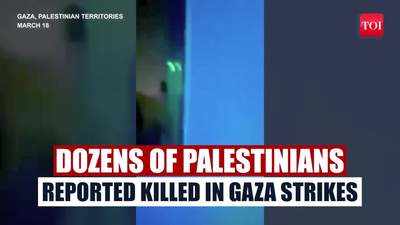- News
- World News
- Middle East News
- Over 50,000 killed in Palestine as war with Israel rages on amid collapsing ceasefire
Trending
Over 50,000 killed in Palestine as war with Israel rages on amid collapsing ceasefire
The Gaza Strip has seen an intense resurgence in violence, with recent Israeli airstrikes killing over 50,000 Palestinians since October 2023. The collapse of a ceasefire has escalated the humanitarian crisis, leading to mass displacement and severe shortages in medical supplies and essential services.
The Gaza Strip has witnessed a devastating escalation in violence, with the Palestinian health ministry reporting that over 50,000 Palestinians have been killed since the outbreak of war with Israel on October 7, 2023.
Overnight Israeli airstrikes targeted multiple locations across the southern Gaza Strip, including the city of Rafah, resulting in at least 26 Palestinian deaths. Among the casualties were Hamas leader Salah Bardawil and his wife.
The collapse of the ceasefire has also led to renewed displacement, with Israeli forces ordering evacuations in heavily bombarded areas. Residents of Rafah's Tel al-Sultan neighborhood were instructed to leave on foot, navigating perilous conditions amid ongoing military operations. This mass displacement adds to the humanitarian crisis, as thousands seek refuge in overcrowded and under-resourced shelters.
Ceasefire breakdown and renewed hostilities
On March 18, 2025, Israel launched a series of surprise airstrikes across Gaza, effectively ending the ceasefire. The Israeli government cited security concerns and alleged violations by Hamas as justification for the renewed military campaign. The initial bombardment resulted in over 400 Palestinian deaths, marking one of the deadliest days since the conflict began.
Humanitarian crisis
Hospitals are operating beyond capacity, grappling with shortages of medical supplies and personnel. The destruction of infrastructure has impeded the delivery of essential services, including water, electricity, and sanitation. International aid agencies have called for immediate cessation of hostilities to allow for the safe passage of humanitarian assistance.
The international community has expressed deep concern over the escalating conflict. The United Nations has urged both parties to exercise restraint and return to negotiations.
Civilian impact and displacement
The civilian population in Gaza bears the brunt of the ongoing conflict. Continuous airstrikes and ground operations have led to widespread displacement, with families forced to flee their homes multiple times. The destruction of residential areas has left thousands homeless, seeking refuge in overcrowded shelters that lack basic amenities.
Access to education and livelihoods has been severely disrupted, compounding the long-term socio-economic challenges facing the region.

About the Author
TOI World DeskEnd of Article
FOLLOW US ON SOCIAL MEDIA









